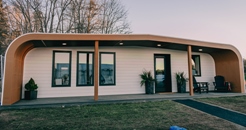 A 3D-printed BioHome, a 100-percent recyclable house
A 3D-printed BioHome, a 100-percent recyclable house
From an article by Reasons to be Cheerful
A project in Maine has set its sights on a neighbourhood of 600-square-foot, 3D-printed, bio-based houses crafted from materials like wood fibers and bioresins. The aim: a complex of 100-percent recyclable buildings that will provide homes to those experiencing houselessness.
In late 2022, an initiative including the University of Maine unveiled its prototype — BioHome3D, (lots of photos here of outside and inside) the first 100-percent recyclable house. It is fully bio-based, meaning all materials will be derived from living organisms such as plants and other renewable agricultural, marine and forestry materials.
Once the pilot project is completed and the team reaches full commercial capacity, the team will be able to print a home in as little as two days - that is the shell of the house — the roof, walls, floors system but could extend in the long-term to include cabinets, countertops, bath fixtures, etc. The materials are also all renewable. And thanks to its natural composition, the home acts as a carbon sink, sequestering 46 tons of carbon dioxide per 600-square-foot unit.
The materials for this project mainly come from wood left over by local mills. This is usually put to landfill, discard or set off to the side and left to rot. Each 600-square-foot unit requires approximately 10 tons of wood residuals.
And after enduring a year of extreme weather in Maine, with sensors reporting temperatures ranging from -17C to 41C, BioHome3D met all sustainability, strength, and durability requirements for US building codes, as well as the design requirements of the International Code Council code.
Initial printing speeds of 20 pounds per hour have since ramped up to nearly 500 pounds per hour, significantly reducing construction costs. This efficiency, combined with local materials, makes the process more sustainable and resilient to global supply chain disruptions.
3D-printed houses produce significantly less waste than conventional construction, as builders are able to print exactly the amount of material they need for a given project, and minimal space is needed for storage materials. And with the ability to store all materials in the same space, the energy otherwise required to transport materials between sites is eradicated.
Read the full article here.
Retweet about this article:
From an article by Reasons to be Cheerful, 24/04/2024